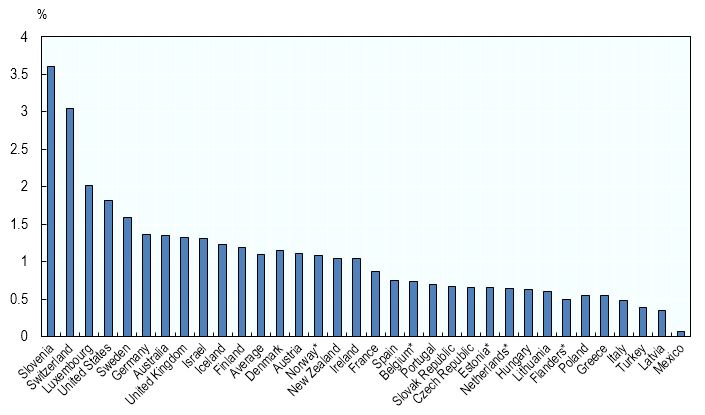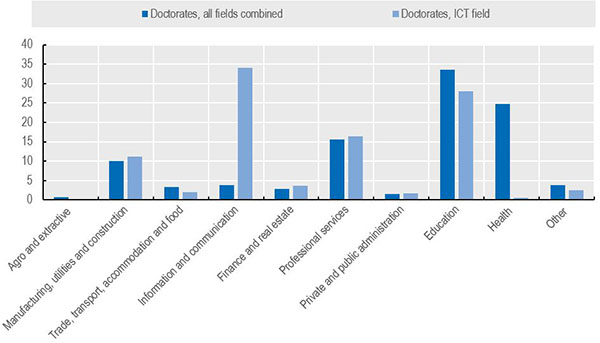Science, technology and innovation policy
OECD work on careers of doctorate holders
Last updated: 3 July 2019
Latest data | CDH project background | Related OECD indicators and analysis | Technical guidelines and earlier results
Why track the careers of doctorate holders (CDH)?
Human resources are key to the generation of ideas and their diffusion. Doctorate holders are of particular relevance to research and innovation because of the deep field-specific knowledge and advanced training in the quantitative and qualitative analytical skills necessary to push knowledge beyond its current boundaries. Doctoral programmes exist in both academic and professional fields and usually require the submission and defence of a thesis, dissertation or equivalent written work of publishable quality that represents an original and significant contribution to knowledge in the respective field(s) of study.
Share of doctorate holders in the population, 2017
25-64 year olds
Note: *Participating in the Benchmarking Higher Education System Performance exercise 2017/2018.
Source: Adapted from OECD Education Statistics (2018). StatLink: https://doi.org/10.1787/888933941538
The 2017 CDH database is the outcome of collaboration between the OECD Directorate for Science, Technology and Innovation and the OECD Directorate for Education and Skills. A joint data collection last took place in Q2-Q3 2017, targeting a core set of indicators on doctorate holders present in both Labour Force Surveys ad hoc CDH surveys ("CDH light").
The compressed file database available for download (.zip) comprises:
- Two flat files corresponding to the generic and field-based questionnaire data modules used by countries for reporting to OECD.
- Extended metadata file incorporating complementary information to help interpret the data submitted by each individual country.
- A codebook that explains the content of the variables and the main differences in populations of reference and classification used by countries and areas reported.
The distribution of ICT doctorates across industries
As a percentage of all doctorates with a degree in ICT or any field
Note: Estimates based on data for BEL, BRA, CAN, CHE, DEU, FIN, GBR and NLD.
Source: OECD calculations based on OECD data collection on Careers of Doctorate Holders 2017 (database)
Background and history of the CDH project
In 2004, the OECD Working Party of National Experts on Science and Technology Indicators (NESTI), along with other international organisations and the support of member countries and partners, set out to develop internationally comparable indicators on the careers and mobility of doctorate holders. Based on national experiences, an expert group with country representatives and international organisations was formed to develop the technical components of the project and promote consistent data compilation at national level.
Since then, the Careers of Doctorate Holders (CDH) initiative has sought to promote the implementation of a horizontal survey instrument targeting the full population of doctorate holders, rather than specific, recent cohorts, as well as covering all institutional sectors of employment, in order to map research skills use economy wide as opposed to focusing on academic careers only. This instrument has sought to address challenges found in other sources (e.g. qualification attainment misreporting, timeliness in Census data and exhaustiveness in Labour Force surveys). Adoption is, however, limited and results have to be interpreted with caution as data submitted by countries are based on a combination of multiple data sources.
Where to find OECD indicators and analysis relevant to CDH
The CDH work is currently under review by the OECD, pending ongoing resource prioritisation. Data and indicators on CDH can be retrieved from multiple OECD data sources:
- Data on ISCED Level 8 (doctorate or equivalent) students and graduates are available from the joint collection of education data by the United Nations Educational, Scientific and Cultural Organisation (UNESCO) Institute for Statistics (UIS), the OECD and Eurostat. These data, often referred to as UEO data, are regularly featured in the flagship OECD publication Education at a Glance.
- Also under the aegis of the OECD Working Party on Indicators of National Education Systems (INES), the Network on Labour Market, Economic and Social Outcomes of Learning (LSO) on National Educational Attainment Categories (NEAC) collects comparable data on educational attainment and labour force status as reported by national labour force surveys. Indicators are also featured in Education at a Glance.
- The Database on Immigrants in OECD Countries (DIOC) contains data based on population censuses carried out in OECD countries and other economies, with details for doctorate-level graduates.
- The OECD Science, Technology and Industry Scoreboard is a flagship publication of the OECD Directorate for Science, Technology and Innovation. The STI Scoreboard reports on available indicators, including data collected from specific CDH data collections or combined with NAEC or DIOC data.
- The OECD Benchmarking Higher Education System Performance Programme at the OECD Directorate for Education and Skills seeks to provide a comprehensive review of the performance of higher education systems, with the objective of linking metric data with policies and practices. This programme’s 2019 report incorporates indicators based on the CDH-2017 data collection.
- The OECD International Survey of Scientific Authors (ISSA) targets authors who have published in scientific peer-reviewed journals, most of which with a doctorate. This study aims to collect information on their activities from the underpinning research to its ultimate outcomes.
- The OECD Research and Development database reports data on human resources dedicated to R&D based on organisational data collected and reported by national statistical bodies drawing on guidance contained in the OECD Frascati Manual. Many countries report data on human resources devoted to R&D by level of qualification.
Technical guidelines for CDH and earlier CDH project results
- In 2011 and 2012, the project benefitted from funding of the 7th Framework Programme of the European Commission as part of KnowINNO grant 257078. The final conference of the KnowINNO project on Careers of Doctorate Holders was held in December 2012 in Brussels.
- Mapping Careers and Mobility of Doctorate Holders: Draft Guidelines, Model Questionnaire and Indicators, 3rd edition (STI Working Paper 2012/7)
- International Standard Classification of Education (ISCED) 2011, UNESCO Institute for Statistics
- Key findings of the OECD-KnowINNO Project on the Careers of Doctorate Holders (2012)
- Careers of Doctorate Holders: Analysis of Labour Market and Mobility Indicators (STI Working Paper 2013/4)
Also available: working paper figures for the 2010/2011 collection
- 2009 CDH indicators (xls) (also available in pdf format).
- Careers of Doctorate Holders: Employment and Mobility Patterns (STI Working Paper 2010/4)
- Labour Market Characteristics and International Mobility of Doctorate Holders (STI Working Paper 2007/2)
- 2006 CDH indicators (xls)
Contact
For further information, please contact sti.contact@oecd.org
Related Documents

